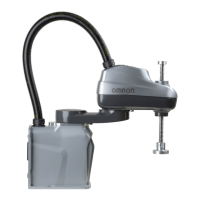Precautions for Correct Use
• Robot motion is not possible until High Power is supplied and has been enabled. Refer to 4-3 Ena-
bling and Disabling the Robot on page 4-5 for more information.
• Control power must be present before High Power can be enabled.
• The T20 pendant can only control the robot it is directly connected to.
• Either a Front Panel or equivalent circuits are required to enable High Power to the robot. Refer to
XFP Wiring Diagram on page 3-24 for more information.
• If the Front Panel High Power ON / OFF indicator fails, you might incorrectly assume that High Pow-
er is OFF, and the robot is safe. To prevent this, a failed indicator causes an error (-924) *Front pan-
el HIGH POWER lamp failure* and locks out the High Power enabling until you replace the indicator.
Refer to the eV+ Language Reference Guide (Cat. No. I605) for more information about error han-
dling. Refer to High Power Indicator Check Procedure on page 3-32 for information about High Pow-
er indicator operation verification.
• It is recommended to use a properly secured, 18 mm (minimum) thick steel plate with a maximum
surface roughness of 25 μm as a robot mounting surface.
• The mounting surface should be clean and prepared according to the information provided in
3-2-1 Robot Mounting Surface on page 3-3 before attempting to mount the robot.
• Do not over-tighten the tool flange setscrew. This will cause off-center alignment of the tool flange
on the quill.
• Always reduce joint motion limits with software configuration settings when hardstops are used to
restrict range of motion. Refer to the Automation Control Environment (ACE) Version 4 User's
Manual (Cat. No. I633) for more information.
• Never loosen or remove the quill clamp collar while the z-axis brake is released.
• If Teach Pendant cabling is installed, the jumper plug or the Teach Pendant must be connected to
satisfy safety circuits and allow High Power to be enabled.
• Do not disable or bypass the High Power button. This will violate IEC 60204-1.
• Operating the robot outside of the payload and speed constraints described in this document can
damage or reduce the service life of the z-axis quill.
• If a Front Panel is not present, the High Power indicator and High Power button signals can be ac-
cessed with the XFP system cable connector. Refer to Front Panel Connections on page 3-21 for
more information.
• Attempting to release the brake while High Power is ON will automatically disable High Power. If the
robot is moving, this will cause it to stop abruptly.
• If no controller(s) is detected, check the Ethernet network and cables and ensure that a network
connection is available to the robot and the PC.
• Only replace items on the robot system with the parts supplied by OMRON.
• Only use the recommended grease on the joint 3 quill. Use THK AFF Grease (part number
20950-000). Refer to the provided Safety Data Sheet for proper handling.
• When removing and replacing the tool flange, you must reinstall it in the same position to avoid los-
ing the calibration for the robot.
• Use surge suppression when switching inductive loads such as relays to prevent damage to the out-
put circuits.
• Any externally mounted equipment is considered robot payload. Consideration to the payload at-
tached to the Tool Flange should be made when mounting external equipment to the robot.
Precautions for Correct Use
20
i4L Robots User's Manual (I658)

